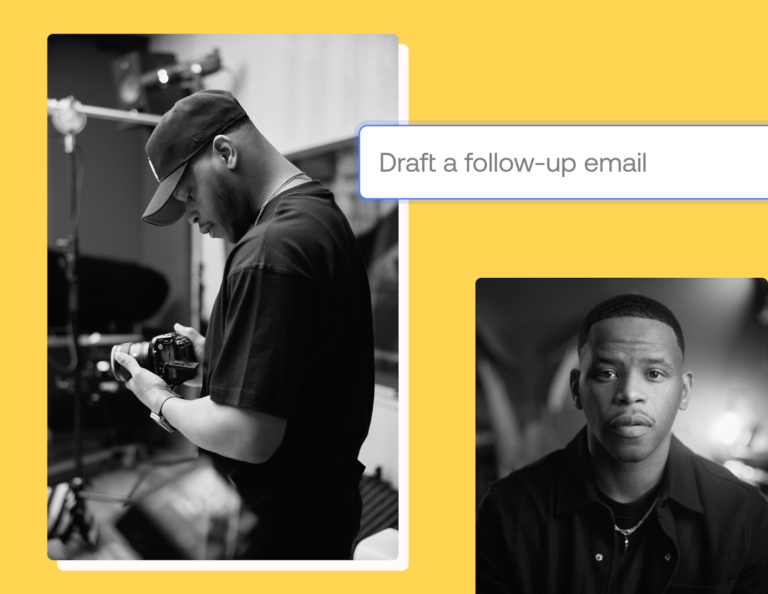From strategically using AI to authentic marketing, these five trends will shape small businesses throughout 2025

Running a small business in 2025 feels a bit like being on a rollercoaster—thrilling, but sometimes terrifying.
We’re navigating through unprecedented and sometimes unpredictable territory—from the ripple effects of the TikTok ban and devastating natural disasters to a huge resurgence of in-person events and a slowly but decidedly rebounding job market.
But that’s not all. AI is here to stay, transforming how we work, live, and run our businesses. At the same time, customer expectations are evolving just as fast. Today, creating personalized experiences and fostering genuine connections is not just important—it’s critical to setting your business apart.
For small businesses, 2025 isn’t just another year of incremental changes—it’s a defining moment. Moving fast and adapting could be the difference between thriving, not just this year, but for many years to come.
That’s why we’ve compiled this roundup of five key trends that will shape small businesses this year. Understanding and adopting these trends isn’t about chasing the next shiny thing—it’s about positioning your business to succeed in an increasingly complex and ever-changing world.
Jump to:
- Building flexible business systems
- Strategically integrating AI in all parts of your business
- Immersive customer experiences
- Authentic and personal marketing
- Returning to a relationship-first business
1. Building flexible business systems
Let’s face it, flexibility is the name of the game for small businesses in 2025. Success today means building systems that can roll with the punches and adapt when things get off-kilter. In 2025—a year that has already been filled with major world events like social media bans, natural disasters, and a rapidly changing economy, we’ll see more and more small businesses build flexibility into their systems.
But what exactly does that flexibility look like? The answer is—a lot of things.
Flexible pricing
It could be giving your customers options with different pricing tiers, and making sure that they’re able to scale up and down in pricing based on what they need, and what’s happening in the economy and world. A good example of this would be a business choosing a lower-cost and lower-touch service with their marketing consultant because they just had a budget cut and need to scale down for the time being.
With a constantly changing market and world—there’s no question that flexibility in pricing will be a need to have—not a nice to have—for small business owners in all industries as we get further into 2025.
Diversifying your revenue streams
It also looks like diversifying your revenue streams so that your business isn’t reliant on a single stream of income. That could be expanding into online courses, different memberships, running workshops, and adding in subscription-based services.
And this has been proven. At HoneyBook, our research has found that high earning small businesses have gone all in on diversifying their revenue— with many of them earning up to 25% of their income from secondary and passive revenue streams.
As more small business owners seek to mitigate risk, protect their income, and candidly not put all of their eggs in one basket—we’ll definitely be seeing a rise in those passive and secondary revenue streams.
Tighter feedback and decision loops
In times of rapid change and uncertainty, it can be tempting as a small business owner to wait and see how the industry responds, or get feedback from a multitude of sources to make sure that your response is just right. The problem is the world is moving faster than ever before—and many times if you’re not first, you’ve often missed out on the opportunity.
That’s why we’ll see quicker, of-the-moment decisions from small business owners in 2025. From pricing promotions to timely marketing campaigns to pivots in what social media to use—making quick strategic decisions is the name of the game this year.
And even though not all of them will be a success, the small business winners of 2025 will be the ones who responded to the moment quickly, had tighter feedback loops, and took bold risks.
2. Strategically integrating AI in all parts of your business
2025 is shaping up to be the year small businesses finally embrace AI, not with a dramatic overhaul, but through thoughtful, strategic adoption.
If you’re feeling a bit uncertain about AI in your business, you’re not alone—plenty of small business owners are in the same boat.
But here’s the encouraging news: AI isn’t—and shouldn’t be—overwhelming or scary. It’s becoming essential in how small businesses work in 2025.
And it’s not about overcomplicating your systems or turning all decision-making over to AI; instead, most small businesses are starting with simple solutions that tackle their biggest time-drains. Routine tasks like email management, responding to inquiries, appointment scheduling, lead qualification and basic customer service are being handed over to AI assistants, giving owners back hours in their week.
What’s particularly interesting about 2025’s AI adoption trend is how it’s reshaping work patterns and giving users more confidence to own decisions. With the rise of AI, business owners are finding themselves with more time to focus on creative projects, in-depth client relationships, and strategic growth—the human elements that truly drive business success.
In 2025, you can expect to see AI integrated in more of your tools and intuitively embedded into more of your workflow. You’ll still be firmly in control, but now, you’ll have the ability to do things faster and easier than ever before.
For small business owners still on the fence, the message from successful adopters is clear: start small, move at your own pace, and let AI help you work smarter, not harder.
3. Immersive customer experiences
In 2025, we’re witnessing a fundamental shift in how small businesses approach customer interactions—it’s no longer enough to simply provide good service.
The most successful businesses are embracing immersive customer experiences, where every touchpoint in the customer journey is an opportunity for connection and personalization. The best part is, today’s technology has made this easily accessible for all businesses, not just larger ones with more money or time.
This looks like thoughtfully designed websites that incorporate fun personal touches like creative copy or out-of-the-box website elements, social media profiles that actively engage with their audiences and try to build community through DMs and comments, and even just simply giving your customers a collaborative voice or view in your process. Even a small moment of delight and personalization in unexpected places, like your booking flow or during the onboarding process, makes a huge difference.
Shaylee Sundby, YouTuber and founder of Burnt Toast Online, a social media consultancy, gives her audience a monthly recap of her August on her Instagram. Giving a high level look into your process and how you work not only creates compelling content, but builds trust in your expertise—creating a better customer experience overall.
Even when it comes to physical spaces like an office or event space—small businesses are designing spaces and moments that are naturally shareable on platforms like Instagram, without feeling forced or artificial.
This shift reflects a broader 2025 trend where businesses understand that in a crowded market, creating a standout customer experience isn’t just a nice-to-have—it’s the difference that turns one-time buyers into long-term retainer clients and brand advocates.
The small businesses that are seeing the most success are those treating every customer interaction as a chance to craft a story worth sharing, whether that’s through personalized communications, interactive product experiences, or collaborative design processes that make customers feel like true partners in the working relationship.
4. Authentic and personal storytelling in marketing
Another striking trend of 2025 is the powerful shift toward authentic marketing in an AI-saturated world. While automation and AI have been huge in changing how we work, they’re also creating an unexpected challenge: standing out in an increasingly automated landscape.
Now there’s a counter-trend where businesses—small and large alike—are investing in human and authentic storytelling. Conventions and norms are being thrown out the window, and businesses everywhere are investing in this specific type of storytelling. From the NFL and their (multiple) behind-the-scenes documentary series, all the way to wedding planners giving their smaller audiences a look into their day on social media—those winning the attention game are the ones getting refreshingly real with their audience.
It’s not just about polished presentations anymore—businesses are finding success by documenting their daily ups and downs, sharing unfiltered behind-the-scenes moments, and letting their point of view shine through.
This is particularly powerful for service-based businesses, where we’re seeing small business owners continue to move away from perfectly curated content in favor of authentic storytelling––especially in the era of AI and automated content. Success stories and customer testimonials are being reimagined as first-person blogs, social media posts, and videos, and businesses are building vibrant communities by sharing their journey, complete with the challenges and victories.
Britt Cunningham, founder of social media agency Britt Social Media, shows a behind the scenes of a slow morning in her life as a social media strategist on her Instagram account. Creating content that is relatable, authentic, and real, is key in cutting through the noise and marketing your business successfully in 2025.
For Akua Konadu, host of our brand new Unbreakable Business podcast, evolving to more authentic and personal storytelling was key when creating a podcast that was not only resonant with her audience, but could stand out in a sea of other podcasts in 2025. For her, it was important to “forget the highlight reels….[and] lean into people’s life experiences.”
Why? Because authenticity is so powerful as a storytelling tool. “You get to see the complete picture: the strategies that worked, the lessons learned…and the mindset shifts that made it all possible” says Akua.
Ironically, as the business world becomes more automated and AI-driven, authentic human connections grow increasingly valuable—creating a unique advantage for small businesses willing to connect genuinely with their audience.
Better yet, as AI handles the routine and tedious tasks, you’ll have more time and energy to focus on thoughtful, creative marketing that showcases your authentic brand.
5. Returning to a relationship-first business
One of the most significant trends reshaping small business success in 2025 is the renewed focus on nurturing long-term customer relationships in an increasingly choice-abundant market.
Our data backs it up: top-performing small businesses are now generating over 50% of their revenue from repeat clients while spending only a quarter of their time servicing these relationships—a powerful testament to the value of retaining and nurturing customers.
What’s most fascinating about all of this is how small businesses are reimagining relationship building in our digital age. We’re seeing a surge in personalized approaches that blend technology with human touch: smart businesses are using digital tools to track and celebrate client milestones, but they’re doing it with authentic, personalized outreach that feels anything but automated.
There’s also a rise of sophisticated loyalty programs for brands of all sizes that aren’t just about points and discounts anymore. Instead, they’re about creating a community of valued customers who feel genuinely appreciated.
Perhaps most intriguing is the trend toward “relationship lifecycle marketing,” where businesses maintain meaningful connections with both current and former clients through thoughtful touchpoints like personalized thank-you notes for referrals and seasonal greetings.
In 2025’s small business landscape, relationship-centric business strategies are proving that customer retention isn’t just good practice—it’s essential for success.
So write that thank you note. Grab coffee with that old client. As automation becomes more integrated into everyone’s daily life, your small business’s growth will not only depend on creating immersive customer experiences and sharing authentic, personal stories––it’ll also depend on keeping your customer base engaged.
Make 2025 your best year yet
While we can’t predict everything 2025 holds, one thing is clear: small businesses that prioritize customer experience and streamline their operations will be the ones that thrive.
Remember, success doesn’t require overnight transformation—small, consistent improvements throughout the year can significantly boost your business in the long term.
Our HoneyBook team is here to support you every step of the way. Get started with our Growth Guide, and explore our January Jumpstart resources designed to help make 2025 your best year yet.



